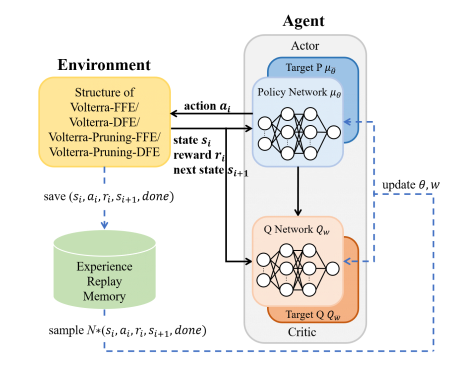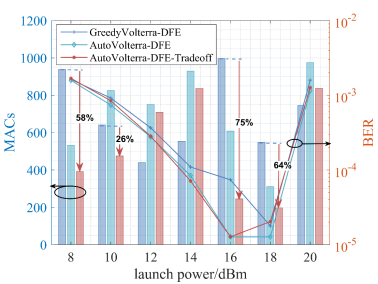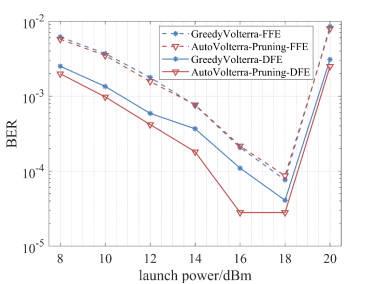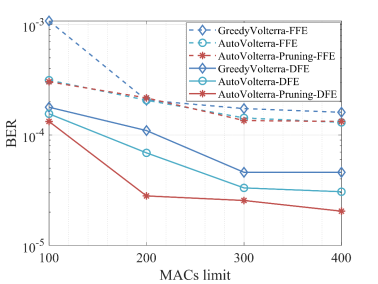Location:Home > News Center >Automatic Struc...
Automatic Structure Optimization - Exploring the Limits of Equalizer Performance

The research group of Professor Lilin Yi from the Department of Electronic Engineering, Shanghai Jiaotong University (LIFE, Laboratory of intelligent fiber ecosystem) studied the automatic structure search algorithm of the Volterra equalizer based on deep reinforcement learning, and discussed the feedforward type, feedback type and their corresponding pruning types. The performance and complexity limit of Volterra equalizers. Through this algorithm, the Volterra equalizer structure with the best equalization effect can be searched under any complexity limit, so that the computing resources can be fully utilized, and it is helpful to deploy the Volterra equalization algorithm on hardware. The relevant results are titled "Automatic optimization of Volterra equalizer with deep reinforcement learning for intensity-modulated direct-detection optical communications" and published in the international optical journal "Journal of Lightwave Technology" in May 2022. Doctoral student Xu Yongxin is the first author, and Professor Lilin Yi is the corresponding author.
Research Background
The Volterra equalizer has powerful nonlinear damage compensation capability and is widely used in optical communication systems. However, the high complexity limits the real-time realization of the Volterra equalizer on hardware, so the structure of the Volterra equalizer needs to be optimized. Traditional optimization methods, such as the commonly used greedy search, are efficient, but the obtained Volterra equalizer structure is often suboptimal, and fine-tuning needs human experience. Therefore, for various Volterra equalizers, such as feedforward Volterra equalizer (Volterra-FFE), feedback Volterra equalizer (Volterra-DFE), etc., the upper limit of equalization performance and the lower limit of complexity under the same equalization effect are still unknown. In addition, when pruning these Volterra equalizers to reduce complexity, it is also difficult to determine the optimal pruning ratio of each order core.
Research Path

Figure 1 AutoVolterra algorithm schematic diagram
In recent years, the deep deterministic policy gradient algorithm (Deep Deterministic Policy Gradient, DDPG) based on deep reinforcement learning has been widely used in automatic control, communication and other fields. This paper designs a given equalizer complexity, Algorithm to automatically search for the optimal structure of various Volterra equalizers - AutoVolterra. The experimental results show that AutoVolterra can improve the equalization effect of the Volterra equalizer and greatly reduce the complexity of the equalizer. In addition, AutoVolterra also incorporates automatic pruning, which can fully utilize computing resources and obtain a more compact equalizer structure, which is helpful for deploying Volterra equalizers on hardware.
The schematic block diagram of the AutoVolterra algorithm is shown in Figure 1. DDPG is used as the agent (Agent), and its output action (action) is the structural parameters of various Volterra equalizers, that is, the memory length of each order, the feedback memory length, and the pruning rate. Then, the equalizer is trained according to the obtained structural parameters, and the bit error rate BERvalid of the equalized signal is obtained. According to different task requirements, two types of reward value calculation methods are designed. If only the best balance effect is pursued, the reward value calculation method is shown in formula (1). To consider the compromise between balance effect and complexity, The reward value calculation method is shown in formula (2), and MACsVNLE is the number of multiply-accumulate operations (MACs) required by the Volterra equalizer.


Figure 2 (a) Diagram of experimental setup, (b) Frequency response curve of back-to-back system
In the C-band, the AutoVolterra algorithm is verified experimentally with the IMDD system based on the Mach-Zehnder modulator (MZM). The modulation signal is 50Gbps PAM4, the transmission distance is 20km, and the receiving power of the avalanche photodetector (APD) is - 15dBm. Using 3 Volterra equalizer of order. The 3dB bandwidth of the system is about 6.1GHz, and the back-to-back system frequency response curve is shown in Figure 2(b).
Research Results

(a)
(b)
Figure 3 Comparison of (a) Volterra-FFE (b) Volterra-DFE searched by different algorithms
Under the limitation of the equalizer complexity of 1000 MACs, the structure of the Volterra-FFE equalizer is searched by greedy search and AutoVolterra, which are respectively recorded as GreedyVolterra-FFE and AutoVolterra-FFE. The reward value calculation method of complexity compromise is the same as the naming rules below. The bit error rate and the actual consumption of MACs are shown in Figure 3(a). From the perspective of bit error rate, using AutoVolterra to optimize the structure of Volterra-FFE does not improve the overall equalization effect significantly. However, judging from the actual consumption of MACs, the use of AutoVolterra-FFE-Tradeoff can ensure that the equalizer complexity is greatly reduced when the equalization effect is close, which shows that Volterra-FFE itself has an inherent low complexity and high equalization performance. structure. For Volterra-DFE, the bit error rate and the actual consumption of MACs are shown in Figure 3(b). From the perspective of bit error rate, using AutoVolterra to optimize the structure of Volterra-DFE can significantly improve the equalization effect. For example, in the transmission power When it is 16dBm, using AutoVolterra avoids the local optimal solution obtained by greedy search, which not only significantly improves the equalization effect, but also greatly reduces the complexity. Judging from the actual consumption of MACs, the use of AutoVolterra-DFE-Tradeoff can achieve a better balance between the equalization effect and complexity of the equalizer.

Figure 4 Comparison of Volterra-Pruning-FFE searched by different algorithms
Figure 4 shows the bit error rate of Volterra-Pruning-FFE (that is, pruning Volterra-FFE) obtained by different algorithms and the actual consumed MACs curve. Among them, GreedyVolterra-Pruning-FFE is greedy pruning based on AutoVolterra-FFE, and AutoVolterra-Pruning-FFE refers to the Volterra-FFE searched by AutoVolterra combined with the pruning algorithm. Comparing the AutoVolterra-FFE benchmark, it can be found that both greedy pruning and AutoVolterra can ensure that the equalizer complexity is greatly reduced with little loss in equalization performance, and AutoVolterra can further reduce it by about 20%. However, if the comparison benchmark is switched to the equalizer structure searched by AutoVolterra-FFE-Tradeoff, it is found that pruning has no effect on reducing the complexity of Volterra-FFE. AutoVolterra-FFE-Tradeoff does not need pruning, but the overall equalization performance and complexity Better than greedy pruning, and almost the same as AutoVolterra-Pruning-FFE. This shows that the effectiveness of previous pruning algorithms for reducing the complexity of Volterra-FFE is due to the lack of a reference benchmark like AutoVolterra-FFE-Tradeoff.

(a)
(b)
Figure 5 (a) Under the limit of 200 MACs, the comparison of the equalizer results searched by different algorithms; (b) when the transmit power is 16dBm, the equalizers searched by different algorithms are in Comparison of results under different MACs constraints
The essence of reducing the complexity of the Volterra equalizer by pruning and other means is to pursue efficient utilization of computing resources. Therefore, AutoVolterra integrates the pruning algorithm, and redistributes the computing resources saved by pruning to the memory length of each order and the feedback memory length of the Volterra equalizer, so that the computing resources can be fully used. Figure 5(a) shows the comparison of the bit error rate of the equalizer obtained by the greedy search Volterra equalizer and the AutoVolterra search combined with the pruning algorithm under the limit of 200 MACs. It can be seen that AutoVolterra, which incorporates the pruning algorithm, is not effective for Volterra-FFE, but for Volterra-DFE, it can allocate computing resources more reasonably, enable Volterra-DFE to overcome bottlenecks, and improve the equalization effect. When the transmission power is 10dBm When the transmission power is 16dBm, the bit error rate drops to below 1e-3, and the bit error rate drops to much lower than 1e-4. Figure 5(b) shows the BER curves of Volterra equalizers obtained by different algorithms when the transmit power is 16dBm. For Volterra-DFE, the structure searched by AutoVolterra with the pruning algorithm under the limit of 200 MACs, its BER The performance is much better than the structures searched by greedy search and AutoVolterra-DFE under the limit of 400 MACs, indicating that AutoVolterra-Pruning-DFE is able to search more compact equalizer structures.
In summary, the AutoVolterra algorithm can not only explore the equalization effect and the limit of the required complexity of various Volterra equalizers, but also provide a comparison benchmark for different equalization algorithms and pruning algorithms, and also provide design assistance for the real-time realization of Volterra equalizers on hardware .
The LIFE research group has been committed to the algorithm design, system architecture design and intelligent development of the optical fiber communication system. At present, the research group conducts in-depth research on channel equalization in optical access network, automatic optimization of equalizer by reinforcement learning algorithm, global optimization of end-to-end performance, new P2MP architecture based on coherent detection, and FPGA implementation and deployment, contributing to the sustainable development of optical access field strength. The work in this direction is supported by the Outstanding Youth Fund of the National Natural Science Foundation of China, the Key Research and Development Program of the Ministry of Science and Technology, and the Shanghai Jiaotong University-Huawei Advanced Optical Technology Joint Laboratory.
For the detailed principle and result analysis of the AutoVolterra algorithm, please refer to the original text: https://ieeexplore.ieee.org/document/9780595

